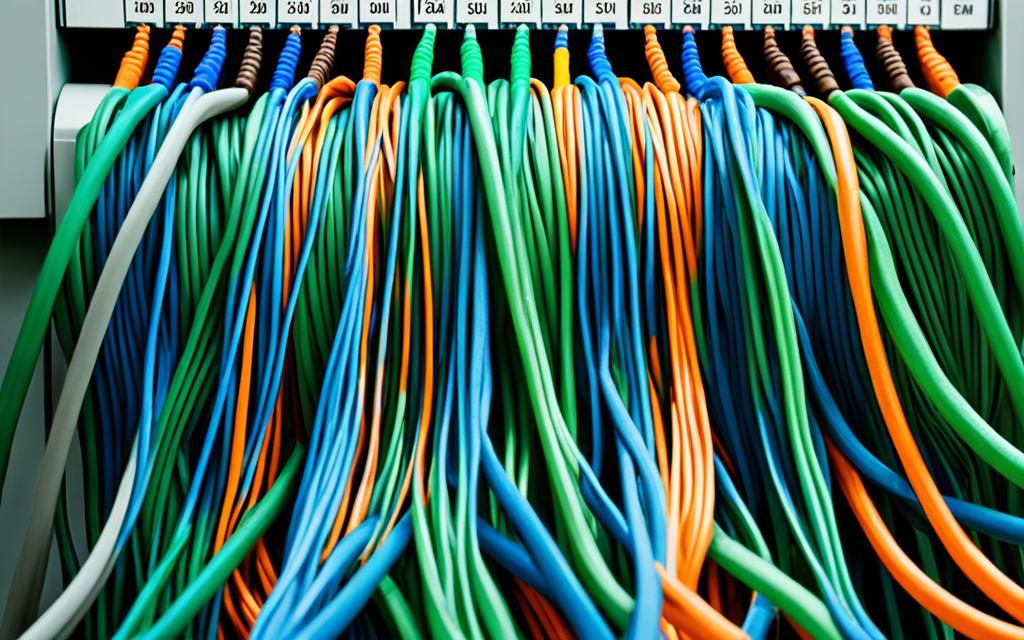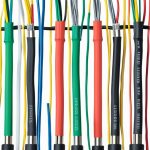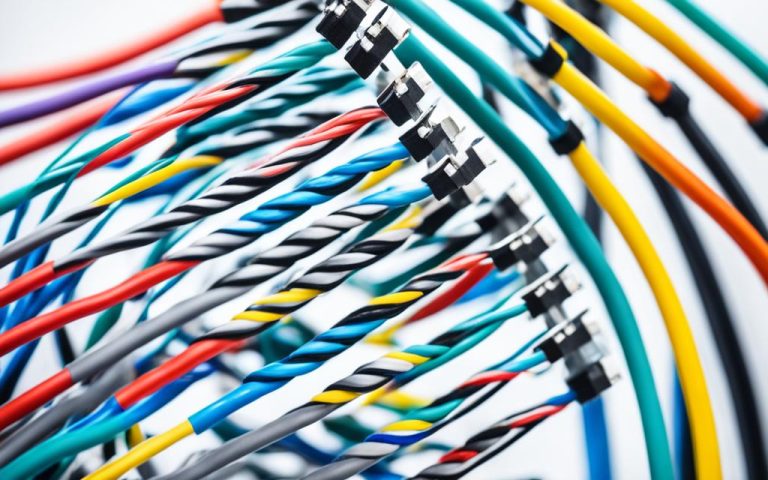The color coding system for network cables plays a crucial role in ensuring proper setup and connectivity in a network infrastructure. Whether you’re a network technician, IT professional, or simply someone interested in understanding the intricacies of network connections, it’s important to grasp the fundamentals of the color coding system for twisted pair cables.
Twisted pair cables, such as Category-5, Category-5E, Category-6, and Category-6E, are commonly used in Ethernet networks. The color coding system helps organize and identify the different wires within these cables, ensuring they are connected correctly for optimal performance.
To help you navigate this system effectively, this article will break down the color coding standards, explain the pin-out configurations, and delve into the significance of each color used in Ethernet cables. By understanding and following the color coding guidelines, you can ensure compatibility and reliable performance in your network connections.
Throughout this article, we will explore the T-568A and T-568B standards, decode the color meanings in Ethernet cables, discuss cable color standards and patch cords, and dive into color coding in Cat6 Ethernet cables. We will also explore wire color coding according to the IEC 60757 standard and highlight the importance of consistency in cable color schemes.
Keep reading to discover the ins and outs of the color coding system of twisted pair cables and gain valuable insights into building and maintaining efficient network connections.
Understanding the T-568A and T-568B Standards
The T-568A and T-568B standards are integral to the proper configuration of Unshielded Twisted Pair (UTP) cables and RJ-45 connectors for Ethernet connectivity. These standards, T-568A and T-568B, offer specific pin-out configurations that ensure effective and reliable network connections.
It is important to note that the T-568A and T-568B standards are not interchangeable and should not be used interchangeably. Each standard serves a specific purpose in different network setups. The T-568A straight-through cable is commonly used as a patch cord for Ethernet connections, connecting a device to a network. On the other hand, the T-568B straight-through cable is used to connect two Ethernet devices directly or to interconnect two hubs. These standards not only ensure the correct pairing of wires in the network but also play a crucial role in maintaining signal integrity and preventing data loss.
For specific applications, such as creating a crossover cable, the green set of wires can be switched with the orange set following either the T-568A or T-568B standard. This configuration allows for the direct connection of two devices without the need for a hub or switch.
Understanding the T-568A and T-568B standards is essential for proper Ethernet connectivity and the successful implementation of network infrastructure. By following these standards, network engineers can ensure the accurate configuration of cables and connectors, optimizing the performance and reliability of their network connections.
| T-568A | T-568B |
|---|---|
| Tx+ | Tx+ |
| Tx- | Tx- |
| Rx+ | Rx+ |
| Unused | Unused |
| Unused | Unused |
| Rx- | Rx- |
| Unused | Unused |
The table above outlines the pin-out configurations for both the T-568A and T-568B standards. It shows the specific wiring arrangement for the Transmit (Tx) and Receive (Rx) pairs, with the unused pins remaining unconnected. This table serves as a visual reference for network professionals when configuring cables according to the T-568A and T-568B standards.
Key Takeaways:
- The T-568A and T-568B standards define pin-out configurations for UTP cables and RJ-45 connectors in Ethernet connectivity.
- T-568A is used as a patch cord, while T-568B is used for direct device-to-device connections.
- Green and orange wire sets can be swapped to create a crossover cable.
- Accurate adherence to these standards ensures optimal network performance and reliable data transmission.
Decoding Ethernet Cable Colors
The colors of Ethernet cables can vary, but they serve specific purposes in different applications. Understanding the color coding system can help ensure proper cable selection for your network needs.
Here are some common Ethernet cable colors and their respective uses:
- Grey Ethernet cables are commonly used for standard Ethernet connections in residential and commercial networks.
- Green Ethernet cables are used for crossover connections, allowing different computers or devices to connect directly.
- Yellow Ethernet cables are often used for Power over Ethernet (PoE) connections, delivering a 30W current to the connected device.
- Blue Ethernet cables are typically used for terminal server connections.
Please note that the color coding for Ethernet cables can vary depending on the organization or industry, as there is no universal standard. It is important to consult the documentation provided by the manufacturer or adhere to any industry-specific guidelines when selecting and using Ethernet cables.
For a visual representation of Ethernet cable colors, please refer to the table below:
| Color | Use |
|---|---|
| Grey | Standard Ethernet connections |
| Green | Crossover connections |
| Yellow | Power over Ethernet (PoE) connections |
| Blue | Terminal server connections |
By understanding the color coding system of Ethernet cables, you can ensure proper cable selection and improve the efficiency and reliability of your network connections.
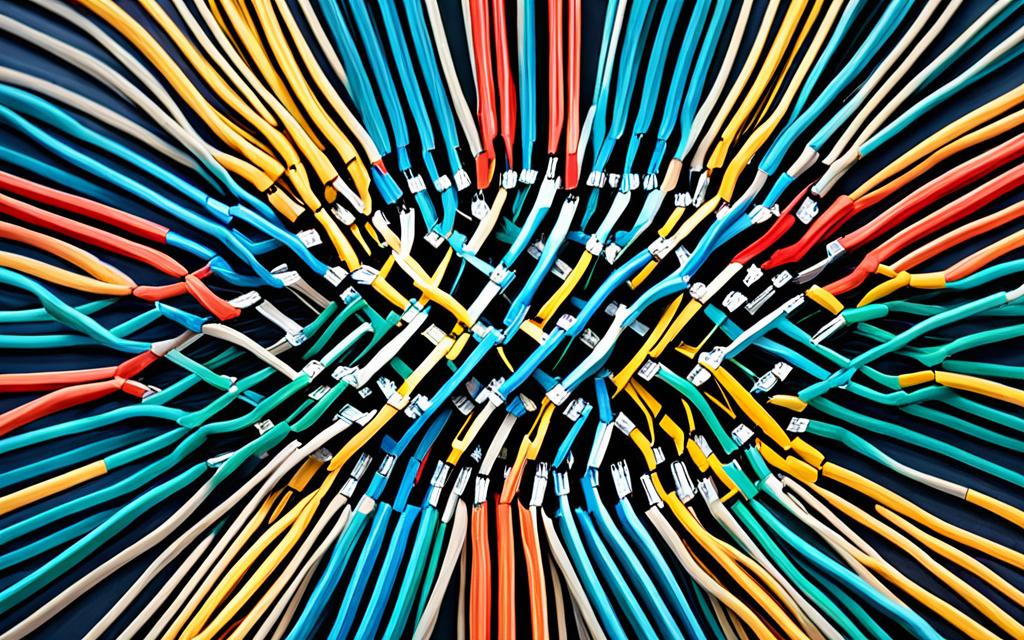
Cable Color Standards and Patch Cords
While there is no universal standard for cable colors, organizations such as the Telecommunications Industry Association (TIA) provide recommendations for color coding used in cable manufacturing. The TIA has defined colors for different types of network connections, offering guidance for cable color standards and patch cords. Following these standards can ensure proper network connectivity and simplify the management of network connections.
The TIA’s color coding standards cover various types of network connections, including standard Ethernet connections, crossover connections, Power over Ethernet (PoE) connections, analog and digital non-Ethernet connections, terminal server connections, and IP cameras. Here is a breakdown of the recommended colors for each connection type:
| Connection Type | Recommended Color |
|---|---|
| Standard Ethernet connections | Grey |
| Crossover connections | Green |
| PoE connections | Yellow |
| Analog non-Ethernet connections | Orange |
| Digital non-Ethernet connections | Purple |
| Terminal server connections | Blue |
| IP cameras | Red |
It’s important to note that these color standards are recommendations and not strict requirements. Different organizations or industries may have their own color coding schemes to suit their specific needs. However, adhering to a consistent color scheme for cable connections can greatly assist with implementing and maintaining network connections.
Color Coding in Cat6 Ethernet Cables
Cat6 Ethernet cables, like other categories of Ethernet cables, do not adhere to a universal color standard. While the color coding on the outside of the cable is generic and helps indicate the purpose of the connection, industry standards for internal twisted wires do exist. These color standards ensure consistency and facilitate proper installation and identification of cable functions.
Here are some common color codes used for Cat6 cables:
- Blue: Typically used for network connectivity.
- Yellow: Frequently used for wired security cameras.
- White: Often employed for interconnections (jumpers).
- Black: Commonly associated with equipment or workstations.
- Red: Frequently utilized for VoIP phone systems or emergency communications.
- And more: Other colors may be employed based on manufacturer and industry requirements.
It’s crucial for installers and network technicians to familiarize themselves with the specific color coding used in their Cat6 Ethernet cables to ensure efficient and error-free connections. By following these color standards, technicians can easily identify and troubleshoot any issues that may arise.
To illustrate the color coding for Cat6 Ethernet cables, refer to the following table:
| Color | Purpose |
|---|---|
| Blue | Network Connectivity |
| Yellow | Wired Security Cameras |
| White | Interconnections (Jumpers) |
| Black | Equipment or Workstations |
| Red | VoIP Phone Systems or Emergency Communications |
Please refer to the image below for a visual representation of Cat6 Ethernet cable color coding:
Understanding the color coding for Cat6 Ethernet cables is essential for proper network setup and connectivity. While there may not be a universal standard, adhering to industry color standards ensures consistency, ease of identification, and reliable performance in network infrastructure.
Wire Color Coding According to IEC 60757
The International Electrotechnical Commission (IEC) has established a standard for wire color coding, known as IEC 60757. This standard assigns specific colors to wire abbreviations according to industry-approved standards. These colors help identify the function and purpose of each wire in a cable, ensuring proper installation and connectivity.
The IEC 60757 standard defines the following wire color abbreviations:
| Wire Color Abbreviation | Wire Color |
|---|---|
| Black (BK) | Black |
| Brown (BN) | Brown |
| Red (RD) | Red |
| Orange (OG) | Orange |
| Yellow (YE) | Yellow |
| Green (GN) | Green |
| Blue (BU) | Blue |
| Violet (VT) | Violet |
| Grey (GY) | Grey |
| White (WH) | White |
| Pink (PK) | Pink |
| Gold (GD) | Gold |
| Turquoise (TQ) | Turquoise |
| Silver (SR) | Silver |
| Green-Yellow (GNYE) | Green-Yellow |
Twisted pairs within a cable also follow a specific color coding pattern according to standards such as DIN 47100.
Example Usage:
When working with an Ethernet cable that follows IEC 60757 color coding, you can easily identify the function of each wire based on its assigned color. For instance, a black wire (BK) may indicate a ground connection, while a blue wire (BU) may indicate a data transmission. This color coding system helps technicians and installers properly connect and troubleshoot cables, ensuring efficient network performance.
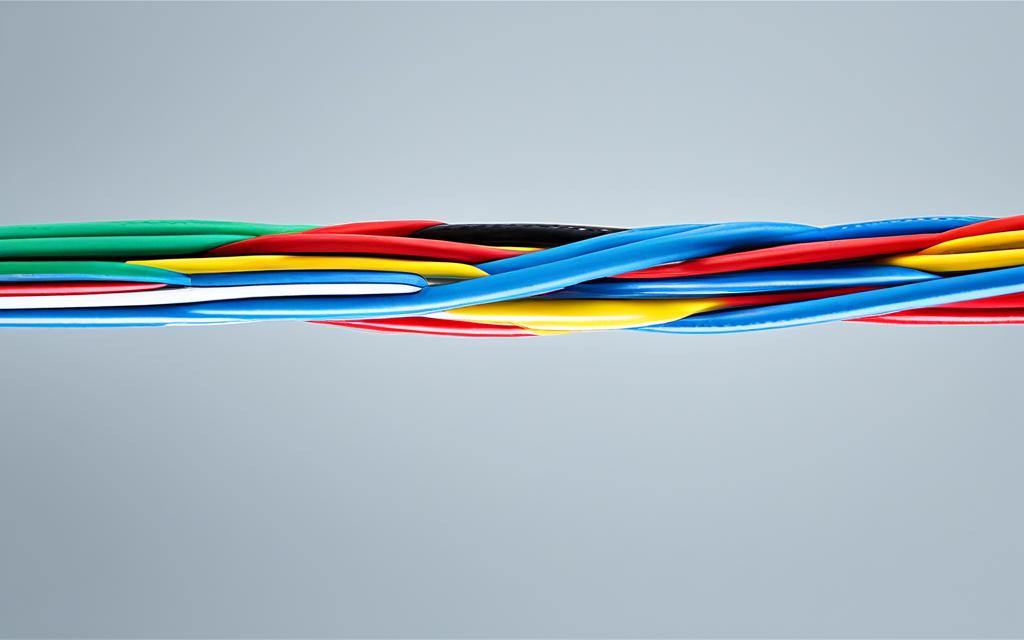
Conclusion
Navigating the color coding system of twisted pair cables is crucial for proper network setup and connectivity. While there may not be a universal standard for cable colors, following industry recommendations and specific color coding patterns is essential. Understanding the different standards and pin-outs, as well as the purpose of each color in Ethernet cables, helps ensure compatibility and reliable performance in network infrastructure.
Consistency in color schemes for patch cords and internal wiring is also important. By staying consistent with color coding, implementation and maintenance of network systems become easier. This consistency facilitates troubleshooting and reduces the chances of errors during installation or upgrades.
Whether it’s the T-568A and T-568B standards for Ethernet connectivity, the cable color recommendations from organizations like the Telecommunications Industry Association (TIA), or the wire color coding standards like IEC 60757, understanding and following these guidelines is vital for network professionals. By adhering to these standards, network administrators can ensure seamless connectivity, reduce downtime, and foster efficiency in network operations.
FAQ
What is the purpose of the color coding system for network cables?
The color coding system for network cables is essential for proper setup and connectivity in a network infrastructure. It ensures that cables are organized and connected correctly, preventing any loss of network connectivity.
What are the T-568A and T-568B standards?
The T-568A and T-568B standards define the pin-out configurations for using Unshielded Twisted Pair (UTP) cables and RJ-45 connectors in Ethernet connectivity.
Can the T-568A and T-568B standards be used interchangeably?
No, the T-568A and T-568B standards are not interchangeable and should not be used interchangeably.
What are the purposes of T-568A and T-568B straight-through cables?
A T-568A straight-through cable is often used as a patch cord for Ethernet connections, while a T-568B straight-through cable is used for connecting two Ethernet devices directly or two hubs together.
How can a crossover cable be created?
A crossover cable can be created by switching the green set of wires with the orange set, following either the T-568A or T-568B standard.
What are the different colors of Ethernet cables used for?
The colors of Ethernet cables serve specific purposes in different applications. For example, grey Ethernet cables are commonly used for standard Ethernet connections in residential and commercial networks. Green Ethernet cables are used for crossover connections, allowing different computers or devices to connect directly. Yellow Ethernet cables are often used for Power over Ethernet (PoE) connections, delivering a 30W current to the connected device. Blue Ethernet cables are typically used for terminal server connections.
Are there universal standards for cable colors?
No, the color coding for Ethernet cables can vary depending on the organization or industry, and there is no universal standard.
What are the color standards recommended by the Telecommunications Industry Association (TIA)?
The TIA has defined colors for standard Ethernet connections (grey), crossover connections (green), PoE connections (yellow), analog non-Ethernet connections (orange), digital non-Ethernet connections (purple), terminal server connections (blue), and IP cameras (red).
Do Cat6 Ethernet cables have a universal color standard?
No, Cat6 Ethernet cables, like other categories of Ethernet cables, do not have a universal color standard. The color coding for the outside of the cable is generic and helps indicate the purpose of the connection. However, industry standards for internal twisted wires do exist.
What are some common color standards for Cat6 cables?
Some common color standards for Cat6 cables include blue for network connectivity, yellow for wired security cameras, white for interconnections (jumpers), black for equipment or workstations, and red for VoIP phone systems or emergency communications.
What wire colors are assigned by the IEC 60757 standard?
The IEC 60757 standard assigns specific colors to wire abbreviations such as black (BK), brown (BN), red (RD), orange (OG), yellow (YE), green (GN), blue (BU), violet (VT), grey (GY), white (WH), pink (PK), gold (GD), turquoise (TQ), silver (SR), and green-yellow (GNYE).
What is the purpose of wire color coding according to IEC 60757?
The wire color coding according to IEC 60757 helps identify the function and purpose of each wire in a cable. Twisted pairs in a cable also follow a specific color coding pattern according to standards like DIN 47100.

